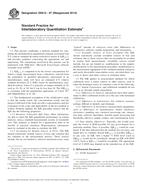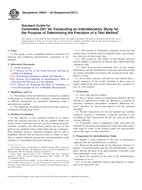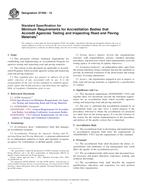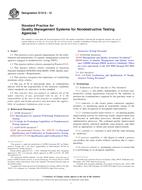Potřebujeme váš souhlas k využití jednotlivých dat, aby se vám mimo jiné mohly ukazovat informace týkající se vašich zájmů. Souhlas udělíte kliknutím na tlačítko „OK“.
ASTM D6689-01(2011)
Standard Guide for Optimizing, Controlling and Reporting Test Method Uncertainties from Multiple Workstations in the Same Laboratory Organization
Automaticky přeložený název:
Standardní Guide pro optimalizaci, Controlling a reporting zkušební metoda Nejistoty z více pracovních stanic ve stejné laboratoři organizace
NORMA vydána dne 1.5.2011
Informace o normě:
Označení normy: ASTM D6689-01(2011)
Poznámka: NEPLATNÁ
Datum vydání normy: 1.5.2011
Kód zboží: NS-36153
Počet stran: 7
Přibližná hmotnost: 21 g (0.05 liber)
Země: Americká technická norma
Kategorie: Technické normy ASTM
Kategorie - podobné normy:
Anotace textu normy ASTM D6689-01(2011) :
Keywords:
accreditation, proficiency testing, workstation, Laboratory water testing, Multiple workstation control, Optimizing test method uncertainties, Uncertainty, ICS Number Code 03.120.20 (Product and company certification. Conformity assessment)
Doplňující informace
| Significance and Use | ||||||||||||||||
|
Many analytical laboratories comply with accepted quality system requirements such as NELAC chapter 5 (see Note 2) and ISO 17025. When using standard test methods, their test results on the same sample should agree with those from other similar laboratories within the reproducibility estimates (R2) published in the standard. Reproducibility estimates are generated during the standardization process as part of the interlaboratory studies (ILS). Many laboratories participate in proficiency tests to confirm that they perform consistently over time. In both ILS and proficiency testing protocols, it is generally assumed that only one workstation is used to generate the data (see 6.5.1). Note 2—NELAC chapter 5 allows the use of a Work Cell where multiple instruments/operators are treated as one unit: the performance of the Work Cell is tracked rather than each workstation independently. This guide is intended to go beyond the Work Cell to achieve the benefits of monitoring workstations independently. Many laboratories have workloads and/or logistical requirements that dictate the use of multiple workstations. Some have multiple stations in the same area (central laboratory format). Others' stations are scattered throughout a facility (at-line laboratory format). Often, analysis reports do not identify the workstation used for the testing, even if workstations differ in their testing uncertainties. Problems can arise if clients mistakenly attribute variation in report values to process rather then workstation variability. These problems can be minimized if the laboratory organization sets, complies with, and reports a unified set of measurement quality objectives throughout. This guide can be used to harmonize calibration and control protocols for all workstations, thereby providing the same level of measurement traceability and control. It streamlines documentation and training requirements, thereby facilitating flexibility in personnel assignments. Finally, it offers an opportunity to claim traceability of proficiency test measurements to all included workstations, regardless on which workstation the proficiency test sample was tested. The potential benefits of utilizing this protocol increase with the number of workstations included in the laboratory organization. This guide can be used to identify and quantify benefits derived from corrective actions relating to under-performing workstations. It also provides means to track improved performance after improvements have been made. It is a prerequisite that all users of this guide comply with ISO 17025, especially including the use of documented procedures, the application of statistical control of measurement processes, and participation in proficiency testing. The general principles of this protocol can be adapted to other types of measurements, such as mechanical testing and on-line process control measurements such as temperature and thickness gauging. In these areas, users will likely need to establish their own models for defining measurement quality objectives. Proficiency testing may not be available or applicable. It is especially important that users of this guide take responsibility for ensuring the accuracy of the measurements made by the workstations to be operated under this protocol. In addition to the checks mentioned in 6.2.3, laboratories are encouraged to use other techniques, including, but not limited to, analyzing some materials by independent methods, either within the same laboratory or in collaboration with other equally competent laboratories. The risks associated with generating large volumes of data from carefully harmonized, but incorrectly calibrated multiple workstations are obvious and must be avoided. |
||||||||||||||||
| 1. Scope | ||||||||||||||||
|
1.1 This guide describes a protocol for optimizing, controlling, and reporting test method uncertainties from multiple workstations in the same laboratory organization. It does not apply when different test methods, dissimilar instruments, or different parts of the same laboratory organization function independently to validate or verify the accuracy of a specific analytical measurement. 1.2 This standard does not purport to address all of the safety concerns, if any, associated with its use. It is the responsibility of the user of this standard to establish appropriate safety and health practices and determine the applicability of regulatory requirements prior to use. |
||||||||||||||||
| 2. Referenced Documents | ||||||||||||||||
|
Podobné normy:
Historická
15.1.2014
Historická
1.6.2011
Historická
1.6.2012
Historická
1.11.2012
Historická
1.11.2012
Historická
1.11.2006



 ASTM D6512-07(2014)..
ASTM D6512-07(2014).. ASTM D6631-05(2011)..
ASTM D6631-05(2011).. ASTM D7495-12
ASTM D7495-12 ASTM E1212-12
ASTM E1212-12 ASTM E1359-12
ASTM E1359-12 ASTM E1763-06
ASTM E1763-06
 Cookies
Cookies
